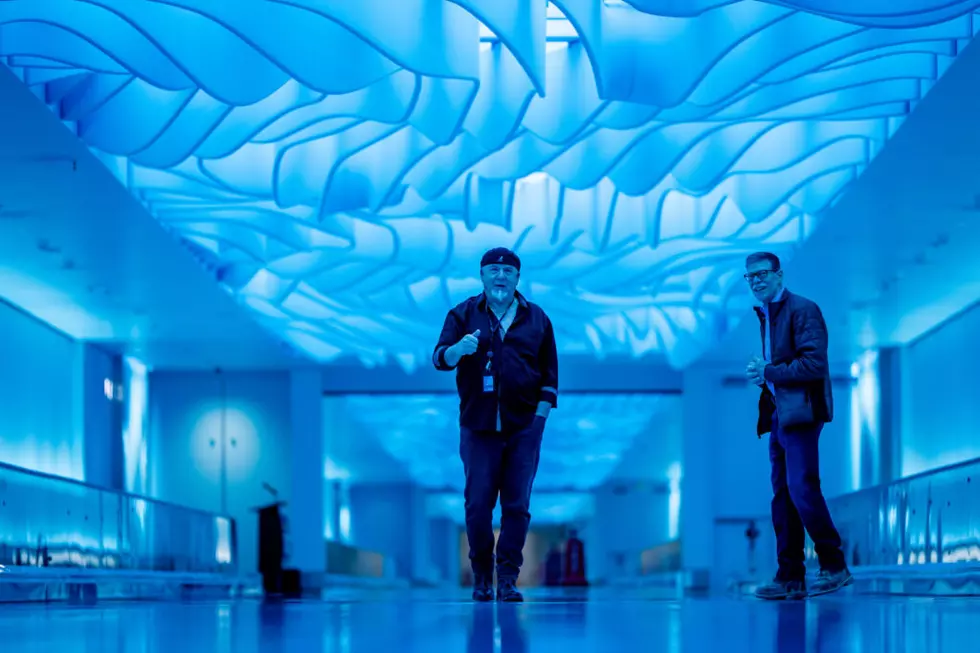
SLC Airport undergoes ‘second transformation’ with new central tunnel
Alixel Cabrera
(Utah News Dispatch) Those who have used the Concourse B of the redeveloped Salt Lake City International Airport know about “the walk,” a stretch of more than 2,000 feet that most passengers have to hike to get to and from the B gates.
But that may change this October, when a shorter, more artistic tunnel opens to the public.
A monochromatic blue installation simulating the flow of a river, with terrazzo floors and waves of tubes covered in fabric, adorns the new central tunnel. Starting Oct. 22, travelers will cut their trek to certain Concourse B gates through the 1,200-foot tunnel while their skins and luggage take on a blue hue from the multiple lights of the art installation.
The shorter walk was always the intended design, Bill Wyatt, executive director at the Salt Lake City Department of Airports said during a tour of the new tunnel on Wednesday. But building it earlier would have meant disrupting the old airport’s activity for years. That’s why the new facility has used the longer Concourse A to B connection since 2004.
The new tunnel may not solve all the walking distance complaints the airport constantly receives, Wyatt said, but it is one of the most substantial changes in the airport since phase 1 of the renovation opened in the fall of 2020.
Project manager Mike Williams agreed.
“This year really is the second transformation because we really tied the whole thing together,” Williams said. “So you’ll have a travel experience from the time you arrive to wherever your gate is, without having to do anything special, like walk extra miles.”
The tunnel’s price tag was about $80 million and about $5.5 million went to the art installation. Though the corridor is almost done, its link to Concourse B is not ready yet, but will be on Oct. 22.
The airport also received $20 million from the federal government earlier this year to fund a portion of the B concourse expansion, including the construction of 16 new gates. All airport projects are funded by airport revenue, federal grants, bonds and passenger facility charges.
Gordon Huether, a California-based artist created and built the installation. Huether has worked on the existing art installations in the airport, including The Peaks, a sculpture inspired by the Wasatch Mountains located in the airport’s entrance, and The Canyon, a set of waves resembling a canyon illuminated by red and orange lights during the day and blue and purple at night.
Though the current version of the River Tunnel is moody, with different shades of baby and darker blues illuminating the stretch, Huether’s vision was even “darker and moodier.” But, “people started freaking out a little bit. So we don’t call that ‘compromise,’ we call that ‘collaboration,’” he said.
Huether did succeed with another idea; adding a speaker system to play an eclectic mix of about 100 songs along the path; from Pavarotti, to Post Malone.
“There’s a meditative quality to it, there’s an inspirational quality to it,” Huether said.
Sitting under that tunnel is a project that’s expected to remain untouched for about a decade while airport officials work on Concourse B: A path for a small train. Finishing that project Wyatt said, will depend on the volume of traffic in the airport.
As of February 2024, more than 27 million passengers traveled from and out of the airport in the course of 12 months. Whenever that number grows to 35 million, the Department of Airports will start the construction of Concourse C.
Completing the train just as far as Concourse B, before Concourse C is built, would only save about 400 feet of the walking distance, “which is less than a downtown city block,” Wyatt said.
